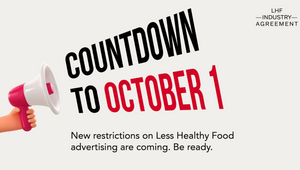
Effectiveness Hinges on the Long AND Short of It

On October 10th 2023, IPA EffWorks
Global (a hybrid
conference) will provide unparalleled opportunities for brands and agencies to
arm themselves with the knowledge needed to navigate marketing effectiveness,
and improve business performance. In the weeks leading up to the event, LBB is discussing the crucial themes in effectiveness today with some of the leading
thinkers in the conversation.
Today ‘The Long and Short of It’ is one of the most influential pieces of research about marketing effectiveness, with savvy marketers using its findings to inform their decision making process. When the paper was first published in 2013, however, it didn’t immediately make a great splash. Co-authored by Les Binet, group head of effectiveness at adam&eveDDB, and Peter Field, marketing consultant, the research entered the world during an era when performance marketing was at its fever pitch.
“Many marketers then were infatuated with performance metrics and short-term gains; they hadn’t yet experienced or perceived problems with that process,” recalls Peter.
The research found a number of key truths about the activities that produce short-term versus long-term effects, concluding that a 60:40 split (with the former geared towards long-term brand building activities) was the key to brand health. One of the insights from ‘The Long and Short of It’ states that “the way in which long-term effects are generated is fundamentally different from how most short-term effects are produced. Although long-term effects always produce some short-term effects, the reverse is not true and long-term effects are not simply an accumulation of short-term effects.” It’s a powerful idea that should have made marketers stop and reconsider their tactics right there and then; instead, at least five years went by, in Les and Peter’s estimation, before the research’s findings started to seep through.
“As the years went by a lot of businesses started to see that something was wrong, they began to ask questions and ‘The Long and Short of It’ offered some answers,” Peter says.
The answers offered were:
- Emotional campaigns, and in particular those that are
highly creative and generate powerful fame/buzz effects, produce considerably
more powerful long-term business effects than rational persuasion campaigns.
- Rational campaigns produce more powerful short-term sales effects and so are very seductive to organisations focused primarily on short-term results. They will not deliver maximum long-term success, however.
- The most successful rounded approach is to develop highly creative fame campaigns supported by powerful activation to drive short-term sales whilst the brand effect gains momentum.
It’s all too easy to extrapolate that creativity and activity that creates fame should be the number one focus for brands - which many erroneously did - when the research itself argues for a nuanced and balanced approach to advertising strategies.
Emphasis on the ‘AND’
“That’s why it’s called ‘The Long AND Short of It,” emphasises Les. “We said that you need advertising that balances an emotional approach with activation that works on a rational level. The emotional and the rational need to be working in different places, across different media, and over different timescales, typically in that 60:40 ratio.”
Peter echoes the research from System1, a marketing research and effectiveness company, which found that the industry is getting worse at executing emotional brand building. He continues: “There are a few potential reasons behind this but the main one is that we’ve had 15 years, as an industry, of being taught how to do really good short-term activations and communication; all the rational stuff has influenced the type of advertising we now do and made us less good at emotional, seductive advertising.”
Our current moment is nonetheless a hopeful one as more marketers are utilising the findings from Les and Peter’s research to counteract the outdated fixation on performance marketing above all else. There’s data to support this too. At this year’s Cannes Lions festival, Dr Grace Kite, founder and economist at Magic Numbers, demonstrated that the trend of over-investment in short-term digital media is slowly being reversed as more marketers adhere to brand growth principles and the findings from ‘The Long and Short of It.’
“There are hopefully signs, at least in terms of how people are allocating the budget. We see that the companies that get it and understand the need to invest in the long-term seem to be achieving increased effectiveness,” adds Les. “Finally the message that budgets need to be balanced between short and long-term activity is getting across. It’s quite heartening to see tech giants taking it on board.”
Les points to Jeff Bezos, who said in 2009 that, “Advertising is the price you pay for having an unremarkable product or service,” only to become America’s biggest advertiser through Amazon in 2020. “Tesla will have to advertise eventually. Google said that it wants to move away from short-term attribution metrics towards econometrics as they build up YouTube into its own brand channel,” he adds.
Amazon is continuing its heavy foray into advertising by calling on adam&eveDDB specifically, which recently won the account. “Amazon called and said that it wants some of the emotional magic for itself,” says Les. The emotional magic in question is of course the work that adam&eveDDB has done for John Lewis across its Christmas campaigns, arguably launching the trend for the blockbuster emotional festive showing from all brands who dare enter the highly competitive ring. The company helped to establish John Lewis as the emotive centre of consumers’ Christmas shopping experience and made headlines for the brand every time a new campaign launched.
Three of the biggest tech companies - Google, Amazon, and
Apple, the latter of which has always gone in on emotional advertising - are
all now moving in the direction of effectiveness as outlined in ‘The Long and
Short of It.’ “I think the extraordinary financial success of advertising like
the kind John Lewis has engaged in over the course of a decade has started a
countertrend and inspired a return to good old fashioned emotional
storytelling,” says Les.
Moving beyond performance metrics
It has taken companies like Amazon, Facebook, and Google years to realise the error of their ways and to start engaging in the strategies that create long-term brand health. “The little companies will catch up,” thinks Les. Peter observes a trend where “people with money” become cognisant that start-ups hit a wall and paid search and growth hacking activities stop providing the kind of results they once did. “You can’t just use performance techniques to drive growth - it’s too expensive and it doesn’t work. That’s when you have to bring in the brand and hopefully there’s the financial muscle to do it,” Peter adds.
Les has a few clear pointers for brands and marketers looking to start investing properly in that 60:40 ratio. “The most important thing is mental availability. You've got to reach people, you've got to get noticed, you want to make the brand famous. Then you need this emotional halo. So the first thing is to make sure that people think of your brand. But then once you've got them thinking of your brand, you need to get them to think well of your brand. Emotion plays a triple role. Emotional advertising gets you noticed, emotional advertising makes people feel good about the brand, and emotional advertising creates more durable memories.” It’s not a prescriptive approach, however. “Exactly how a brand does this is the magic of creativity and there are no simple rules for it,” he adds.
The approach, as outlined by Les, is a framework and not scripture to be followed uncritically or, worst of all, without creativity. “There’s a slight danger at the moment of marketers using our principles and performing a box ticking exercise, rather than using them as a starting point,” highlights Peter. “Once you start getting into emotional brand building, that’s when you really start to earn your money as an agency and a marketer because the risk of failure is higher but the rewards and success are massively greater.” Peter is clear that simply performing a box ticking exercise means that the work will never rise above the mediocre. “Great marketing and advertising isn’t just about the science and the strategy. It’s about the magic and the extent to which you create the scope and the latitude for agencies to do really, really great work.”
There are guidelines to how this “magic” can be executed, like balancing the tension between the new and the continuous so that a brand lives in people’s imagination, becoming part and parcel of their lives, and offers a fresh perspective to counteract staleness too. It’s no mean feat. “Specsavers does it well,” says Les. “Innovation, doing something new and unexpected is a way of getting that tension though it can affect continuity. That's one of the reasons why there can never be a complete set of rules, because sometimes what you need to do is what everyone else is not doing. What works changes over time, depending on the social context, the advertising context, the political contexts, perceptions. And we can’t forget the importance of sheer craft too, that’s also really hard to get right,” he adds.
Peter offers suggestions on how to move forward. “Always remember the power of creativity, always seek it, always try and allow the space for it to happen. And that is tough. And also just be obsessed with your brand. At the moment, there's too much obsession with ROI and short-term responses. You want to measure all of those; obviously, they're important. But you've got to temper that with an obsession with brand. New businesses should obsess about the strength and the health of their brands.”
To prove the point that effectiveness lives at the intersection of rationality and creativity, Peter draws our attention to a 1975 Australian campaign from the margarine brand, Meadow Lea, ‘You Oughta Be Congratulated’, the title of which was key to the campaign’s catchy jingle. “It was a hugely successful campaign, very populist, it made the brand very famous and it wasn’t based on huge amounts of science,” he points out. So why did the brand decide that people in the campaign “oughta be congratulated” for using Meadow Lea’s margarine. “The creative team were looking for a word that rhymed with ‘polyunsaturated.’”
To hear more from Les
and Peter on lessons from The Long and The Short of It, ten years on, get your
tickets for IPA EffWorks
Global 2023 – a hybrid
conference where creatives, strategists, brand marketing and agency leaders
alike can get involved in effectiveness. Les and Peter will be two of many
expert speakers sharing knowledge on what effectiveness in marketing means
today.













